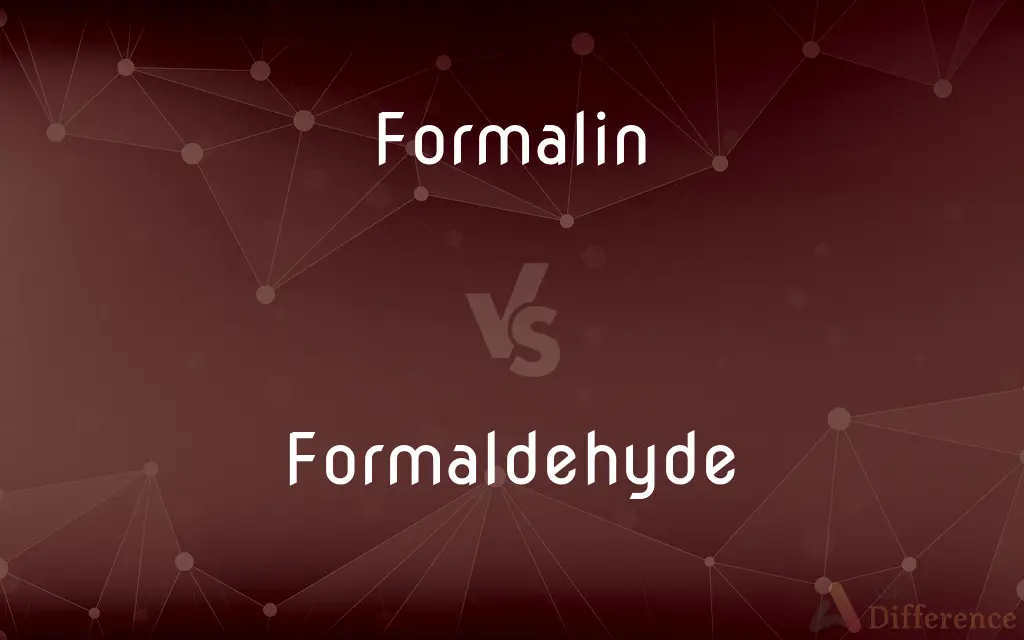Formalin vs. Formaldehyde — What's the Difference?
Edited by Tayyaba Rehman — By Fiza Rafique — Updated on September 26, 2023
"Formalin" is a solution of formaldehyde gas in water. "Formaldehyde" is a colorless gas used in making formalin and various products.

Difference Between Formalin and Formaldehyde
Table of Contents
ADVERTISEMENT
Key Differences
"Formalin" is an aqueous solution of formaldehyde. "Formaldehyde" is a colorless, pungent-smelling gas.
Formalin: It typically contains around 37% formaldehyde and water. Formaldehyde: It is the primary component in formalin.
Comparison Chart
Composition
Aqueous solution with formaldehyde as a major component
Pure gaseous formaldehyde
Physical State
Liquid
Gas
Common Use
Preservation (e.g., embalming), disinfection
Manufacturing, adhesives, preservatives
ADVERTISEMENT
Concentration
Contains approximately 37% formaldehyde
Pure formaldehyde gas
Handling
Easier to handle and measure in liquid form
Requires specialized handling due to gaseous state
Compare with Definitions
Formalin
Commonly used in medical and scientific applications.
Formaldehyde
"The formaldehyde emissions needed to be controlled."
Formalin
"Formalin" is an aqueous solution of formaldehyde.
Formaldehyde
"Formaldehyde" is a colorless, pungent-smelling gas.
Formalin
"The laboratory used formalin to preserve specimens."
Formaldehyde
"Formaldehyde is used in the production of plastics."
Formalin
A liquid containing formaldehyde used for various purposes.
Formaldehyde
A gas employed in manufacturing and chemical processes.
Formalin
"The formalin solution was diluted for safe use."
Formaldehyde
Known for its preservative and adhesive properties.
Formalin
An aqueous solution of formaldehyde that is 37 percent by weight, usually also containing 10 to 15 percent methanol to prevent polymerization of the formaldehyde.
Formaldehyde
Formaldehyde ( (listen) fer-mal-duh-hahyd, also (listen) for-) (systematic name methanal) is a naturally occurring organic compound with the formula CH2O (H−CHO). The pure compound is a pungent-smelling colorless gas that polymerises spontaneously into paraformaldehyde (refer to section Forms below), hence it is stored as an aqueous solution (formalin).
Formalin
A solution of formaldehyde in water; used as a disinfectant and to preserve biological specimens.
Formaldehyde
A pungent colorless flammable gaseous compound, CH2O, the simplest and most reactive aldehyde, used for manufacturing melamine and phenolic resins, fertilizers, dyes, and embalming fluids and in aqueous solution as a preservative and disinfectant.
Formalin
An aqueous solution of formaldehyde, used as a preservative in museums and as a disinfectant.
Formaldehyde
(organic compound) The simplest aldehyde, HCHO, a colourless gas that has many industrial applications; it dissolves in water to give formol (10%) and formalin.
Formalin
A 10% solution of formaldehyde in water; used as a disinfectant or to preserve biological specimens
Formaldehyde
A colorless, volatile liquid, H2CO, resembling acetic or ethyl aldehyde, and chemically intermediate between methyl alcohol and formic acid.
Formaldehyde
A colorless poisonous gas; made by the oxidation of methanol
Common Curiosities
Where is formalin commonly used?
It's used in preservation, disinfection, and various laboratory applications.
Can formalin be used as a gas?
No, it's a liquid solution.
How is formalin different from formaldehyde?
Formalin is a solution of formaldehyde in water.
Is formalin safe to handle?
It requires care and proper ventilation due to formaldehyde content.
What are common applications of formaldehyde?
It's used in manufacturing, adhesives, and as a preservative.
What is formalin?
Formalin is a liquid solution containing formaldehyde.
What is formaldehyde?
Formaldehyde is a colorless, pungent gas.
How does formaldehyde relate to formalin?
Formalin is an aqueous solution containing formaldehyde.
Is formaldehyde dangerous to health?
Prolonged exposure to high concentrations can be harmful.
Is formaldehyde a natural gas?
It can be produced naturally in small quantities.
Share Your Discovery

Previous Comparison
Calamity vs. Affliction
Next Comparison
Heavyweight vs. WelterweightAuthor Spotlight
Written by
Fiza RafiqueFiza Rafique is a skilled content writer at AskDifference.com, where she meticulously refines and enhances written pieces. Drawing from her vast editorial expertise, Fiza ensures clarity, accuracy, and precision in every article. Passionate about language, she continually seeks to elevate the quality of content for readers worldwide.
Edited by
Tayyaba RehmanTayyaba Rehman is a distinguished writer, currently serving as a primary contributor to askdifference.com. As a researcher in semantics and etymology, Tayyaba's passion for the complexity of languages and their distinctions has found a perfect home on the platform. Tayyaba delves into the intricacies of language, distinguishing between commonly confused words and phrases, thereby providing clarity for readers worldwide.














































